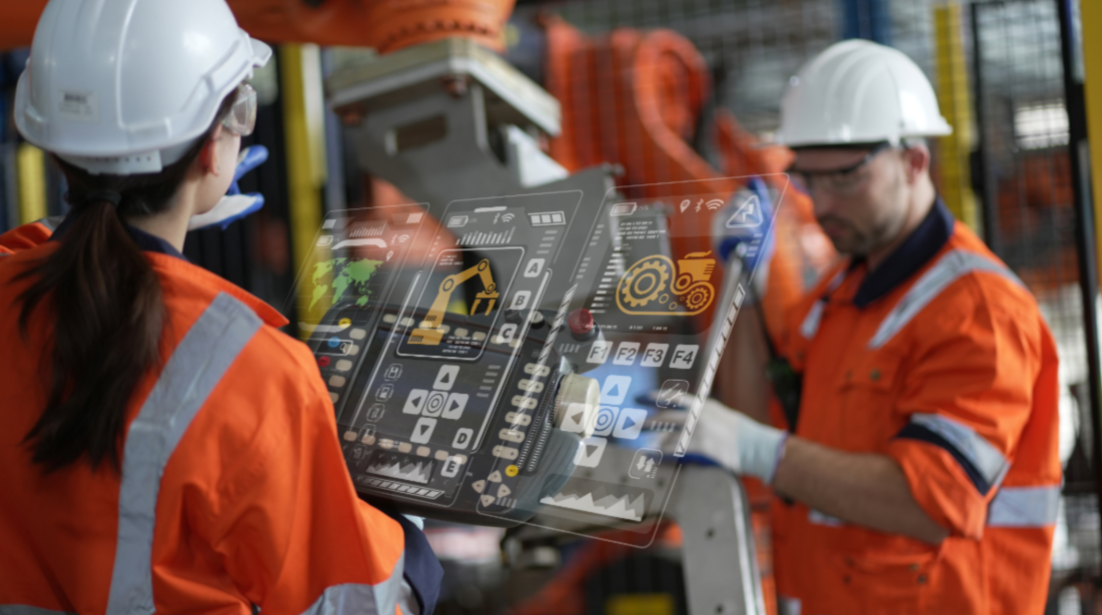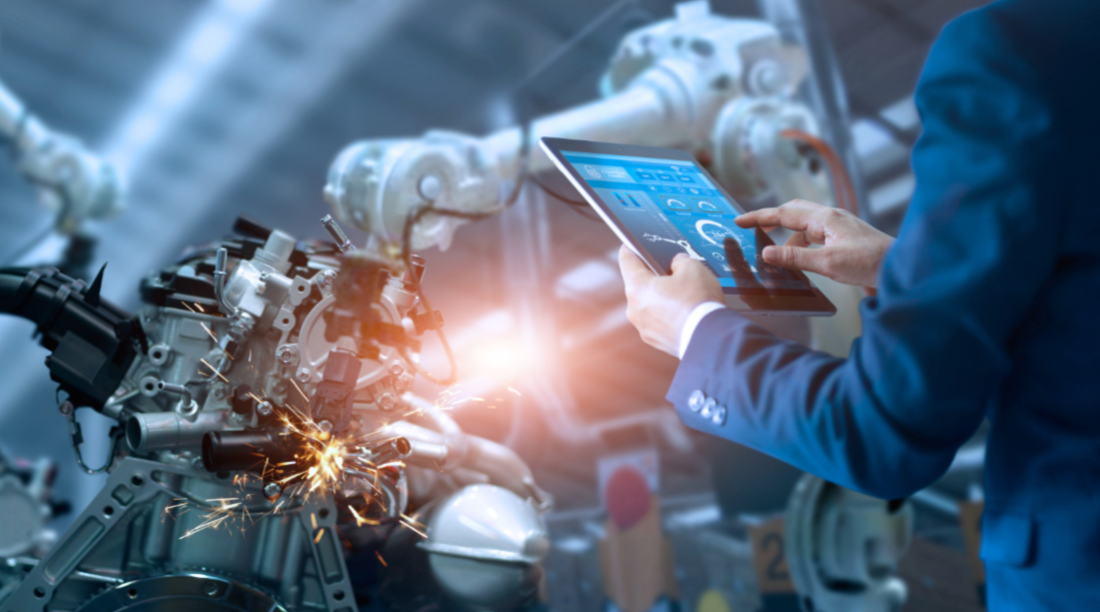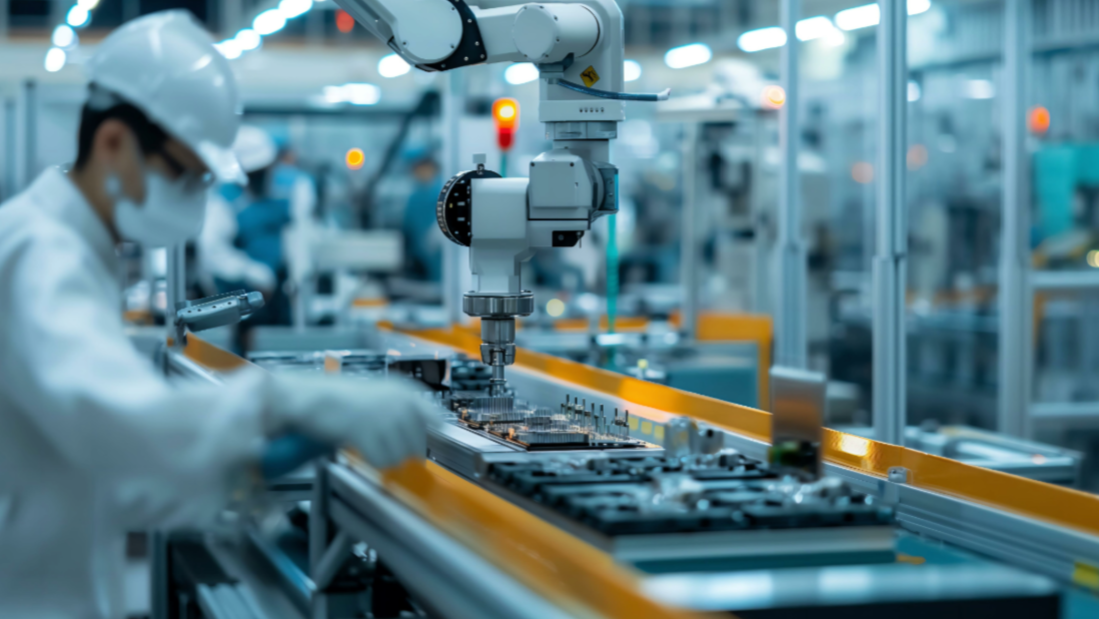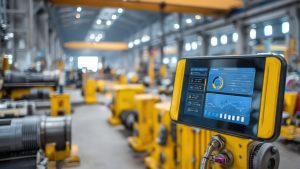The manufacturing industry is undergoing a profound transformation driven by the integration of artificial intelligence (AI) and machine learning (ML). AI and ML in manufacturing are revolutionizing traditional processes, boosting efficiency, and opening new frontiers of innovation. From predictive maintenance to quality control, these technologies are reshaping how products are designed, produced, and delivered.
AI refers to computer systems that can perform tasks typically requiring human intelligence. ML is a subset of AI that allows systems to learn and improve from experience without explicit programming. Together, they’re creating smarter factories, streamlined supply chain management, and more responsive production systems.
The impact of AI and ML in manufacturing is already substantial and growing rapidly. According to McKinsey, machine downtime can be reduced by 30% to 50% and quality-related costs can be reduced by 10% to 20% through the application of these technologies. This is just the tip of the iceberg, as AI and ML continue to evolve and find new applications in the manufacturing sector. Let’s explore how these technologies are shaping the future of industry.
The Benefits of AI and ML for Manufacturers

The adoption of AI and ML in manufacturing brings a host of benefits that are reshaping the industry landscape. These advantages have the potential to revolutionize the way manufacturing companies operate.
Boosting Operational Efficiency
AI and ML are powerful tools for optimizing workflows, reducing cycle times, and eliminating bottlenecks. By analyzing enormous amounts of data from sensors and production systems, AI can identify inefficiencies and suggest improvements in real-time. This data analysis helps make informed decisions and streamline manufacturing processes.
For example, BMW uses AI-managed robots in its production lines, saving $1 million yearly and allowing for the reallocation of workers to more value-added tasks. This showcases how AI can not only cut costs but also enhance human productivity by freeing up workers from repetitive tasks.
Predictive Maintenance for Reduced Downtime
One of the most impactful applications of ML in manufacturing is predictive maintenance. By analyzing data from sensors and historical maintenance records, machine learning algorithms can predict when equipment is likely to fail. This allows for proactive maintenance and reduces the reliance on human inspectors for identifying potential issues.
This approach can significantly reduce unplanned downtime, which is a major cost for manufacturers. In fact, IBM’s X-Force Threat Intelligence Index found that 61 percent of manufacturers’ operational technology was subject to attack. This highlights the importance of robust, AI-driven maintenance systems to ensure smooth production processes.
Enhanced Quality Control
AI-powered vision systems and data analytics are revolutionizing quality control in manufacturing. These systems can identify defects in real-time with a level of accuracy and speed that far surpasses human capabilities. This allows for real-time adjustments during the production process.
According to McKinsey, ML prompts up to a 90 percent improvement in defect detection compared to human inspections. This not only improves product quality but also reduces waste and rework, leading to significant cost savings.
Supply Chain Resilience
AI models are transforming supply chain management by improving demand forecasting, inventory management, and logistics planning. These technologies enable manufacturers to create more resilient and responsive supply chains. This is especially important in today’s dynamic market.
The AI in the supply chain market is projected to reach USD 10,110.2 million by 2025, up from USD 730.6 million in 2018. This rapid growth reflects the increasing recognition of AI’s value in managing complex, global supply networks. AI solutions are being developed to optimize chain management and improve overall efficiency.
Sustainability Gains
AI-driven energy management systems are helping manufacturers reduce their carbon footprint and resource usage. By optimizing energy consumption and minimizing waste, these systems contribute to more sustainable manufacturing practices.
Statistics show that in 2023, all sustainable AI cost-saving measures were reported to have at least a 40 percent impact on enterprise expenses. This demonstrates that sustainability initiatives powered by AI can have a significant positive impact on both the environment and the bottom line. It allows companies to drive innovation while being environmentally conscious.
Real-World Applications of AI and ML in Manufacturing

The theoretical benefits of AI and ML in manufacturing are impressive. Let’s explore some concrete examples of how AI is being applied in the real world to improve production processes.
Smart Robotics
AI-driven robots are transforming assembly lines, welding, painting, and packaging processes. These robots can work alongside humans, improving precision and speed while adapting to changing production demands. This collaboration between humans and machines is enhancing efficiency and productivity on the plant floor.
Ford, for instance, uses six cobots to sand the entire body surface of a car in just 35 seconds. This level of efficiency and precision would be impossible to achieve with human labor alone. Such advancements in robotics are transforming the manufacturing landscape.
AI-Powered Process Optimization
Manufacturers are using AI to adjust machine settings, monitor quality, and optimize processes on the fly. This real-time optimization leads to improved product quality and reduced waste. AI algorithms analyze real-time data from the production process to identify areas for improvement.
For example, in the semiconductor industry, using AI to automate processes can enhance yield by up to 30%, reduce scrap rates and testing costs. This level of optimization is crucial in an industry where even small improvements can lead to significant competitive advantages. It allows manufacturers to stay ahead in a highly competitive market.
Digital Twins
Digital twins are AI-enhanced digital replicas of physical systems used to simulate, predict, and refine manufacturing operations. This technology is revolutionizing the way manufacturers design, test, and optimize their products and processes.
According to a McKinsey survey, 86% of respondents agreed that digital twins are applicable in production operations. These virtual models allow manufacturers to test changes and optimizations in a risk-free environment before implementing them in the real world. This can lead to faster innovation cycles and more efficient problem-solving.
Human-Machine Collaboration
The rise of collaborative robots (cobots) and augmented reality (AR) is changing how humans and machines work together in manufacturing settings. These technologies augment human capabilities, leading to improved productivity and safety. The use of industrial IoT is also contributing to this collaboration by connecting machines and enabling data exchange.
The human augmentation market, which includes these technologies, is expected to surge from USD 330.38 billion in 2023 to a staggering USD 1,249.43 billion by 2033. This growth reflects the increasing adoption of human-machine collaboration technologies in manufacturing and other industries. This trend is driven by the need to increase efficiency and reduce turnarounds in manufacturing plants.
Overcoming the Challenges of AI and ML Implementation

While the benefits of AI and ML in manufacturing are clear, implementing these technologies is not without challenges. Manufacturers need to address these challenges effectively to fully realize the potential of AI and ML.
Financial Barriers
The high upfront costs of AI and ML technologies can be a significant barrier for many manufacturers, especially smaller ones. However, it’s important to consider the long-term ROI of these investments. Companies need to carefully evaluate the costs and benefits before investing in these technologies.
To justify the investment, manufacturers should start with small, focused projects that can demonstrate quick wins. This approach can help build confidence and secure further funding for larger-scale implementations. By showcasing the value of AI and ML through pilot projects, manufacturers can gain support for wider adoption.
Data Management Issues
AI and ML rely on high-quality, well-organized data. Many manufacturers struggle with data integration challenges and the need for robust data governance. Addressing data quality issues is crucial for successful AI and ML implementation.
To address this, companies should invest in data infrastructure and develop clear data management strategies. This might involve partnering with data management experts or investing in employee training to build in-house capabilities. Effective data management is essential for ensuring the accuracy and reliability of AI and ML models.
Workforce Adaptation
Implementing AI and ML often requires a significant cultural shift within an organization. There may be resistance to change, and employees may need upskilling to work effectively with new technologies. Proper training and communication are essential to overcome resistance and ensure a smooth transition.
Companies can manage this transition by involving employees in the implementation process, providing comprehensive training programs, and clearly communicating the benefits of AI and ML for both the company and individual workers. By addressing employees’ concerns and providing them with the necessary skills, companies can foster a positive attitude toward AI adoption.
Security and Privacy Risks
As manufacturing becomes more digitized, cybersecurity concerns increase. Research shows that manufacturers suffer the most from cyberattacks, as even a brief shutdown of the assembly line can prove costly. Protecting sensitive data and ensuring the integrity of AI systems is paramount.
To mitigate these risks, manufacturers need to prioritize cybersecurity in their AI and ML implementations. This includes regular security audits, employee training on cybersecurity best practices, and investing in robust security infrastructure. By implementing strong security measures, manufacturers can safeguard their operations and maintain the trust of their customers.
The Future of AI and ML in Manufacturing

As we look ahead, the potential of AI and ML in manufacturing seems boundless. These technologies are continuously evolving, leading to new possibilities and opportunities for the manufacturing sector. The advancements in AI algorithms are opening up new possibilities for optimization and innovation.
AI-Driven Autonomous Factories
We’re moving towards fully automated, self-optimizing manufacturing plants. While this concept is still largely theoretical, there are already examples emerging. For instance, Japanese robotics manufacturer FANUC has operated a factory without humans since 2001, capable of running unsupervised for up to 30 days. This demonstrates the potential of AI to transform the factory floor and revolutionize manufacturing operations.
Edge AI and IoT Integration
The integration of edge computing and IoT sensors is set to revolutionize data collection and processing in manufacturing. This will enable real-time decision-making and even more responsive production systems. By bringing computation closer to the data source, manufacturers can reduce latency, improve efficiency, and enhance real-time monitoring capabilities.
Augmented Decision-Making
AI will increasingly assist human decision-makers with more accurate insights and predictive analytics. This will lead to better strategic decisions and more efficient operations across the manufacturing value chain. AI-powered tools can provide valuable insights from data, enabling better forecasting, planning, and risk management.
Customized Manufacturing
AI and ML are enabling a shift towards mass customization, allowing manufacturers to meet unique consumer demands efficiently. This trend is particularly evident in industries like automotive and consumer electronics. By leveraging AI and ML, manufacturers can tailor products to individual customer preferences, opening up new markets and enhancing customer satisfaction.
Success Stories: AI and ML Transforming the Manufacturing Landscape
Many companies are already reaping the benefits of AI and ML in their manufacturing processes. These success stories provide insights and inspiration for other manufacturers looking to embark on their AI journey.
| Company | AI/ML Application | Impact |
|---|---|---|
| Siemens | Digital Twin Technology | Reduced development time, improved product quality |
| General Electric (GE) | Predictive Maintenance | Reduced downtime in wind turbines, increased energy production |
| BMW | AI in Quality Control | Improved defect detection, enhanced product quality |
| Tesla | AI in Production Optimization | Increased efficiency and output in production lines |
FAQs about AI and ML in Manufacturing
How is AI and ML used in the manufacturing industry?
AI and ML are used in various ways in manufacturing, including:
- Predictive maintenance.
- Quality control.
- Supply chain optimization.
- Robotics.
- Process optimization.
These technologies analyze vast amounts of data to improve efficiency, reduce downtime, and enhance product quality. AI is helping manufacturers optimize their operations and make data-driven decisions.
What does ML mean in manufacturing?
In manufacturing, ML (Machine Learning) refers to systems that can learn from data and improve their performance over time without explicit programming. Machine learning models can analyze large datasets to identify patterns and make predictions. This could involve:
- Predicting equipment failures.
- Optimizing production schedules.
- Improving quality control processes.
What is the future of AI in manufacturing?
The future of AI in manufacturing points towards:
- More autonomous factories.
- Increased human-machine collaboration.
- More personalized production capabilities.
- Even more sophisticated predictive and prescriptive analytics.
AI is expected to play a central role in creating smarter, more efficient, and more sustainable manufacturing processes.
Which company uses AI in manufacturing?
Many companies are using AI in manufacturing. Some notable examples include:
- Siemens with their digital twin technology.
- General Electric with predictive maintenance for wind turbines.
- BMW for AI-powered quality control.
- Tesla for production line optimization.
The adoption of AI in manufacturing is becoming increasingly widespread across various industries and company sizes.
Conclusion
AI and ML in manufacturing are no longer futuristic concepts but present-day realities that are reshaping the industry. From boosting operational efficiency and enhancing quality control to enabling predictive maintenance and fostering innovation, these technologies are driving a new era of smart manufacturing. The use of learning models and AI algorithms is transforming the way manufacturing companies operate.
As we’ve seen, the benefits of AI and ML in manufacturing are substantial, with the potential to dramatically improve productivity, reduce costs, and drive sustainability. However, implementing these technologies also comes with challenges, including financial barriers, data management issues, and the need for workforce adaptation. Overcoming these challenges requires a strategic approach and a commitment to embracing new technologies.
Despite these challenges, the future of AI and ML in manufacturing looks incredibly promising. As these technologies continue to evolve and mature, we can expect to see even more innovative applications and transformative impacts across the manufacturing landscape. The manufacturing sector is on the verge of a significant transformation, and AI and ML are at the forefront of this change. Manufacturers who embrace these technologies will be well-positioned to thrive in the years to come.
product development neural networks



